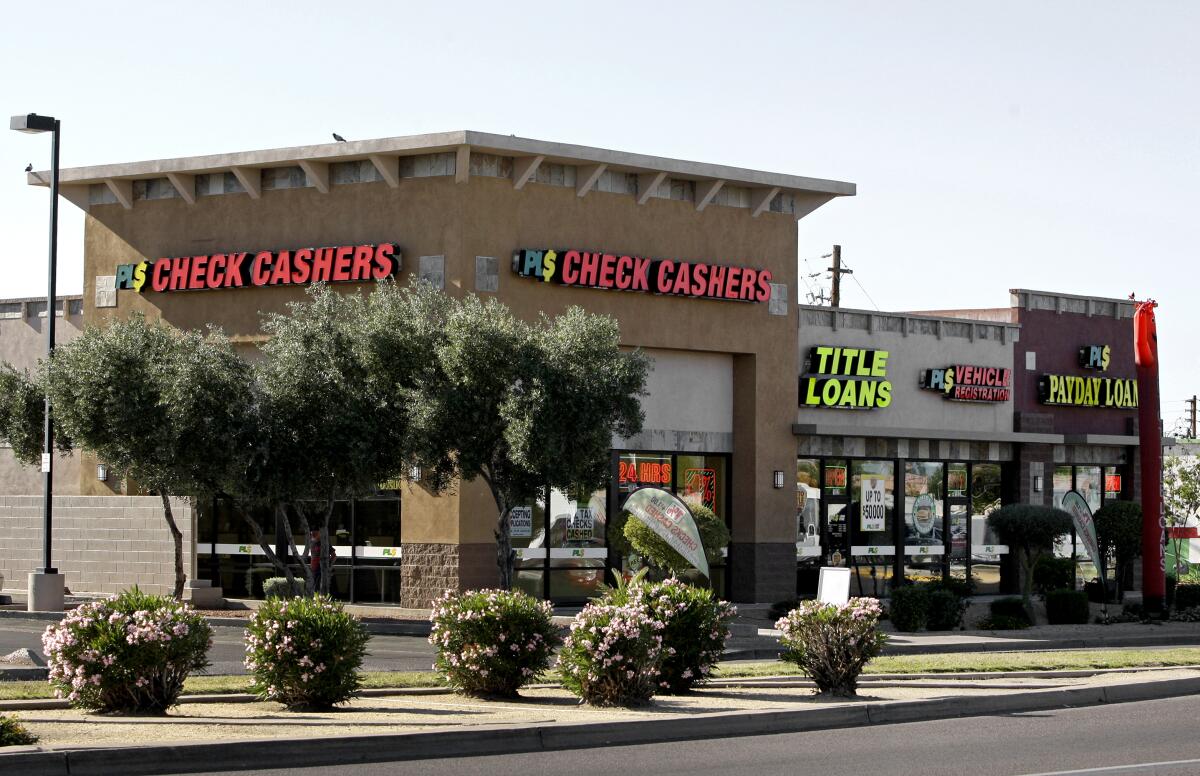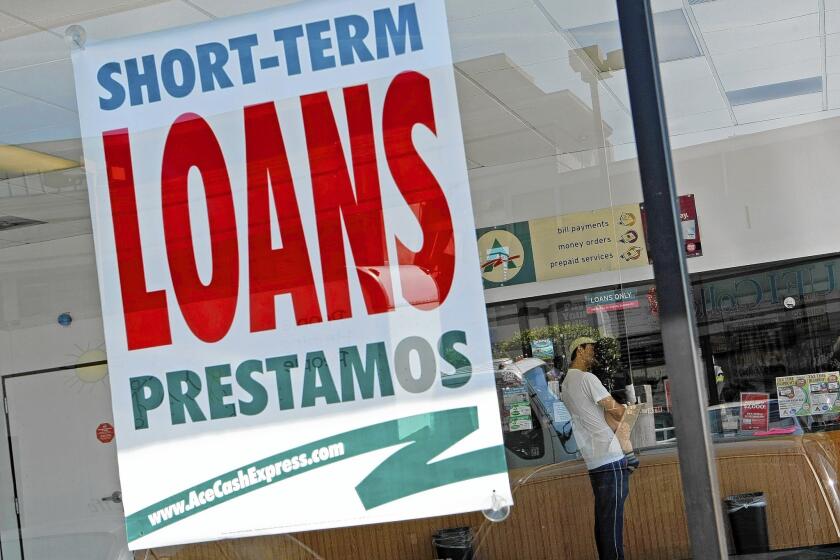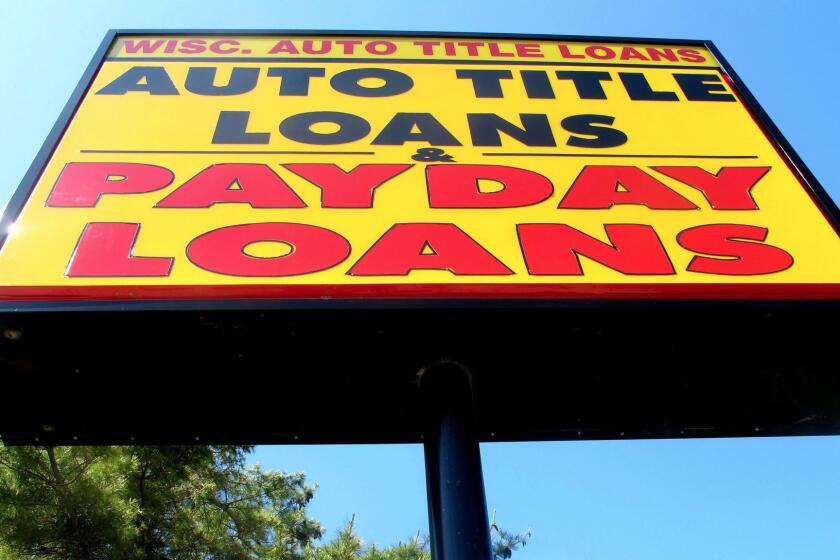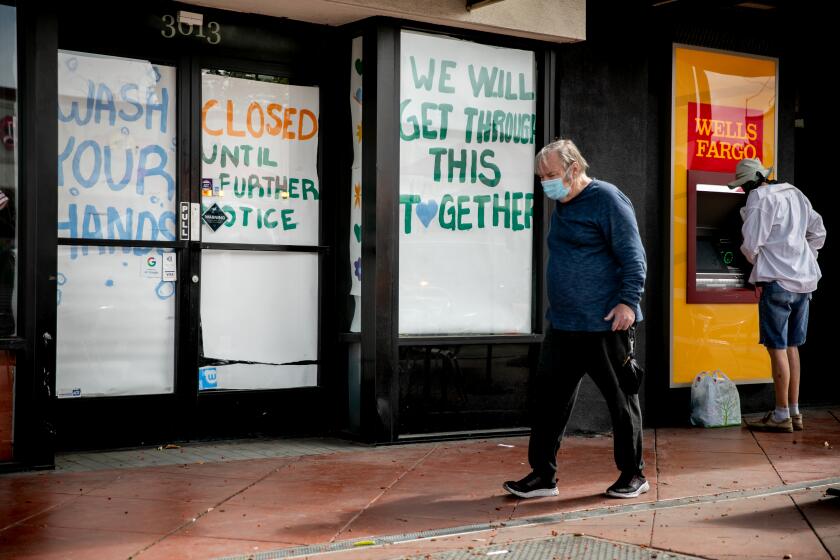Column: There’s a racial gap in marketing by banks and payday lenders, study finds

- Share via
Payday lenders want to lure people of color into endless cycles of high-interest debt. Mainstream banks prefer white people as customers.
At least that’s what academic researchers concluded after reviewing advertising and marketing materials for the two industries.
In a soon-to-be-published paper, researchers at the University of Houston sought to understand why Black and Latino people make up a disproportionately high percentage of customers for payday and auto title lenders. I got a sneak peek at their work.
The researchers found that “while African Americans make up roughly 12% of the Texas population, almost 35% of the pictures on payday and title-lender websites were of African American models.”
“While Latinos comprise less than 20% of payday and title-lending customers, more than 30% of the pictures were of Latino customers,” they found.
“On the other hand, at mainstream banks, almost 30% of the websites did not have a single picture of an African American model. Almost 75% of mainstream banks did not feature a single picture of a Latino individual.”
The researchers said these findings are especially noteworthy coming, as they do, months after the Black Lives Matter protests and amid a nationwide push for greater diversity and social justice.
“Even after the outcry over racial injustice in 2020, banks did not appreciably increase the representation of people of color on their websites,” they concluded. “This needs to change.”
The rule, formulated under President Obama, would have required payday lenders to make sure borrowers could repay high-interest loans.
The paper, scheduled to be published next month in Emory Law Journal, doesn’t break a lot of new ground. It’s long been known that Black and Latino customers make up large shares of the market for payday and auto title lenders.
But this new research provides a statistical framework to help explain why that’s the case — and the seemingly deliberate efforts of the industry to target people of color.
And although the findings don’t necessarily paint the mainstream banking industry as racist, they indicate more work needs to be done if banks want to diversify their customer base and, at the very least, be perceived as inclusive in their marketing.
“Banks aren’t thinking about this carefully enough,” Jim Hawkins, a law professor at the University of Houston and coauthor of the paper, told me. “They’re missing an opportunity to show the public this is important to them.”
Tiffany Penner, a second-year law student and Hawkins’ coauthor, said she was surprised that the faces on banks’ websites were so predominantly white.
“I expected to see more African Americans and Latinos,” she said. “Especially now.”
Hawkins said that while their research focused on Houston-area banks and payday lenders, the findings are applicable to large cities nationwide.
“If mainstream banks in Houston are underrepresenting people of color in their advertising, we would be surprised if the data painted a better picture in other cities,” he told me.
Protections from abusive short-term lenders were set to take effect Monday. The Trump administration is now delaying them by 15 months -- and may get rid of the rules entirely.
A spokesman for the American Bankers Assn. declined to comment. Consumer advocates, on the other hand, were quick to say the paper’s findings come as no surprise.
“There is clear evidence that payday lenders target people of color,” said Marisabel Torres, director of California policy at the Center for Responsible Lending.
She told me her organization is troubled by “any idea that mainstream banks are for white communities, while people who have historically struggled for middle-class security are offered predatory, wealth-stripping products.”
Christine Hines, legislative director for the National Assn. of Consumer Advocates, echoed those concerns.
“The continued exploitation of minority communities with risky and costly payday loan products aggravates the existing racial wealth gap at a time when we should be taking urgent steps to tackle it,” she said.
Infin, a trade group for payday and auto title lenders, declined to comment on the paper’s findings until they could be reviewed.
But Ed D’Alessio, the organization’s executive director, said in a statement that “the mission of the regulated consumer financial services industry is to ensure all consumers have access to cost-effective, transparent financial services and credit options.”
“Our members seek to engage their customers in ways that authentically represent and reflect their experiences and communities, which are as diverse as our country,” he said.
Annual interest rates for payday and auto title loans can top 400%. More than 80% of such loans end up being rolled over into additional loans or followed within days by a new loan, according to the Consumer Financial Protection Bureau.
Half of all payday and auto title loans result in 10 additional loans to cover the original debt, the bureau estimates.
At best, such lenders make credit available to people who might have a tough time securing funds from a bank. At worst, they trap people in unending debt, making economic advancement all but impossible.
A California bill would create BankCal, offering free financial services to the “unbanked” and “underbanked,” whose low wages often are eaten up by high fees
In their paper, Hawkins and Penner argue that Black and Latino consumers frequently resort to high-interest lenders not only because it’s easier than seeking a bank loan but also because the companies aggressively target these communities.
“Pushing African Americans and Latinos outside mainstream banking services and into high-cost, high-risk products creates a second-class tier of banking,” they say.
Hawkins and Penner told me they favor amending the federal Equal Credit Opportunity Act to explicitly prohibit discriminatory advertising. At present, the law addresses discrimination by creditors only in general.
There’s precedent for this change. The Fair Housing Act forbids any marketing “that indicates any preference, limitation or discrimination because of race, color, religion, sex, handicap, familial status or national origin.”
The researchers are also calling on the Consumer Financial Protection Bureau to seek changes to its Regulation B, which prohibits discrimination in financial advertising through “any oral or written statement.”
They’re calling for Regulation B to be amended so that it is “explicitly applicable to pictures in advertisements.”
These commonsense changes shouldn’t be necessary. Businesses shouldn’t have to be told not to discriminate against anyone.
But Hawkins and Penner’s work indicates, for all the attention paid in recent months to fairness and social justice, we still have a long way to go.
More to Read
Inside the business of entertainment
The Wide Shot brings you news, analysis and insights on everything from streaming wars to production — and what it all means for the future.
You may occasionally receive promotional content from the Los Angeles Times.














